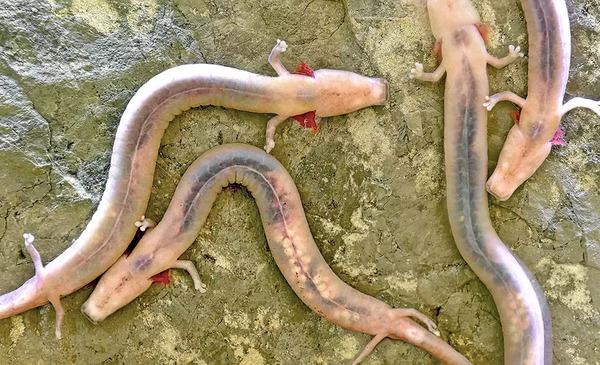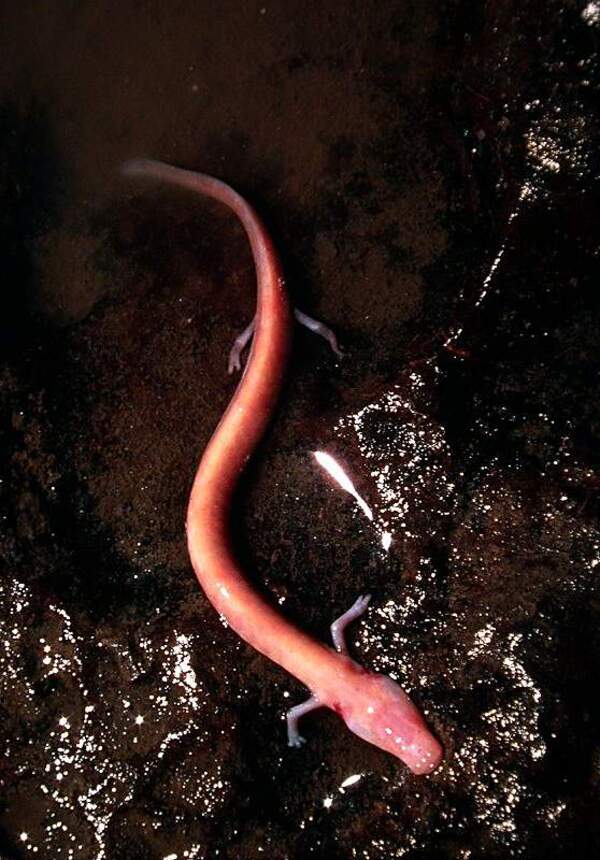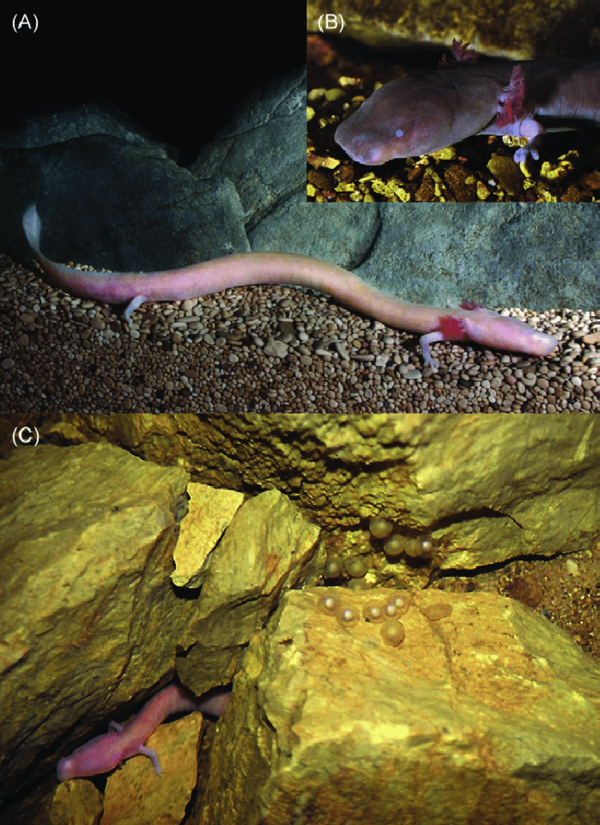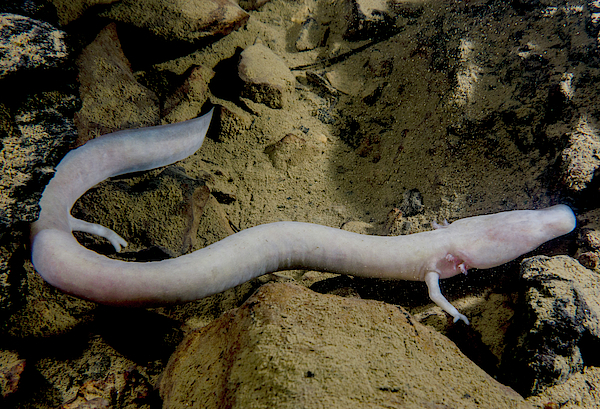Proteus anguinus, also known as the blind cave fish, is one of the most remarkable creatures found in the subterranean water systems of Europe. This fascinating species has evolved in unique ways to survive in complete darkness, making it a symbol of evolutionary ingenuity. In this comprehensive guide, we’ll cover everything from its habitat and physical characteristics to its conservation status and the scientific insights it offers.
Table of Contents
Proteus anguinus, also called the European blind cave fish or olms, is an aquatic salamander species found in the underground lakes and rivers of caves. It is renowned for its adaptations to life in darkness and is a true example of how life can evolve in extreme environments.

This species is most commonly found in caves in the Dinaric Alps, spanning parts of Slovenia, Croatia, and Italy. It has captivated biologists and nature enthusiasts alike due to its extraordinary ability to survive in dark, isolated cave systems with little food and oxygen.
Proteus anguinus lives in dark, underground water systems known as karst landscapes. These landscapes are typically characterized by underground rivers, aquifers, and cave lakes, and they often lack natural light. Cave ecosystems like these are fragile and host unique species that thrive in isolation.
The environment where the fish lives is typically cold, with water temperatures ranging between 8-12°C (46-54°F). The caves in which it resides are oxygen-poor, which poses a significant challenge for most life forms. However, Proteus anguinus has evolved low metabolic rates that allow it to survive in these low-oxygen environments, thriving in places where few other creatures could.
One of the most notable features of Proteus anguinus is its blindness. Over thousands of years, this species has lost its sight due to the total absence of light in its cave habitat. Its eyes are underdeveloped and hidden beneath the skin, giving it an eerie, pale appearance. While it has lost its ability to see, it has evolved other means of perceiving the world.

Loss of pigmentation: Due to its blindness and life in the dark, the fish has a colorless, translucent body. This is another adaptation to its environment, as it saves energy by not producing pigments that are unnecessary in an environment without light.
Enhanced sensory systems: To make up for its lack of vision, Proteus anguinus relies heavily on its sense of smell, taste, and touch to detect food and navigate through the cave. Its chemoreception abilities are highly developed, helping it detect chemical signals from prey, and it uses vibrations in the water to sense movement.
Long, slender body: The fish’s body is elongated and streamlined, allowing it to navigate through narrow underwater passages with ease. This physical characteristic also helps the fish conserve energy as it moves through its environment.
Proteus anguinus is a carnivore that feeds on a variety of small aquatic organisms, such as crustaceans, insects, and worms. The fish hunts by detecting the chemical signals left behind by its prey and is skilled at vibrational sensing, using its lateral line system to detect movement in the water.
Feeding habits: Unlike most fish, the blind cave fish doesn’t rely on vision to hunt. Instead, it uses its highly developed sense of smell and chemoreception to locate food in its dark environment.
Slow metabolism: Due to the scarcity of food in the cave environment, Proteus anguinus has a low metabolic rate. This allows it to survive on minimal amounts of food, sometimes going for weeks or even months without eating.
Behavioral traits: Proteus anguinus is a slow-moving and solitary species, spending most of its time resting in caves. It doesn’t need to spend a lot of energy searching for food due to its efficient sensory system and slow metabolism.

Proteus anguinus is classified as a vulnerable species by the International Union for Conservation of Nature (IUCN) due to its reliance on cave ecosystems, which are under increasing threat from human activities. The species faces several challenges:
Habitat destruction: Pollution from mining, tourism, and industrial waste can contaminate the cave water systems, threatening the survival of the species. Human activity, such as water extraction and construction, can also disturb their delicate underground habitats.
Over-exploitation: In some regions, Proteus anguinus has been captured for scientific study and as an exotic pet, though this has been largely restricted in recent years.
Efforts to protect the fish include designating cave habitats as protected areas, regulating mining and water use, and raising awareness about the importance of these unique ecosystems.
Proteus anguinus is an exceptional example of evolution in action. Over millions of years, this species has adapted to its dark, isolated environment in ways that are still being studied by scientists. Here are some fascinating insights into its evolutionary journey:
Cave adaptation: Proteus anguinus has evolved to thrive in conditions that would be hostile to most other species, including darkness, cold temperatures, and low oxygen levels. The loss of its eyes and pigmentation is a result of natural selection favoring traits that conserve energy in an environment with no light.
Genetic mutations: The fish’s genetic makeup is also a subject of interest, particularly its ability to regenerate parts of its body. Proteus anguinus shares some characteristics with other regenerative species like axolotls, which makes it a valuable subject of research in genetics and biomedical science.
Proteus anguinus is an important subject of study in various fields, including evolutionary biology, genetics, and environmental science. Researchers have focused on several areas:
Genetics: The fish’s loss of vision and pigmentation are the result of genetic mutations. Understanding these mutations can provide insight into how genes control development and survival in extreme environments.
Regeneration: Proteus anguinus has some remarkable regenerative abilities, similar to the axolotl. Studying its regeneration processes can provide insights into tissue repair and stem cell research.
Adaptation to extreme environments: The species has adapted to low-oxygen environments, which makes it an ideal subject for studies on how organisms cope with extreme conditions.
Long lifespan: Proteus anguinus can live for up to 100 years in the wild, making it one of the longest-living aquatic species.
Bioluminescence: While it is not bioluminescent itself, the fish sometimes exhibits a faint glow due to its low-energy metabolism in dark environments.
Sensitive to changes: Proteus anguinus is highly sensitive to changes in its environment, making it an indicator species for the health of underground ecosystems.
Incredible regeneration: Like the axolotl, Proteus anguinus has the ability to regenerate parts of its body, including limbs and organs, making it a valuable study subject for regenerative medicine.

Proteus anguinus is an extraordinary species that showcases the wonders of evolution. Adapted to life in the darkest corners of the Earth, this blind cave fish offers scientists valuable insights into genetics, evolution, and how organisms can survive in extreme environments. With its unique adaptations and ongoing role in scientific research, it remains a fascinating and important creature.
However, the fish’s survival is at risk due to habitat destruction and pollution, making conservation efforts crucial for ensuring that future generations can continue to study this remarkable species. Proteus anguinus is not just a biological wonder but also a symbol of resilience in the face of extreme conditions.
animal tags: Proteus-anguinus
We created this article in conjunction with AI technology, then made sure it was fact-checked and edited by a Animals Top editor.